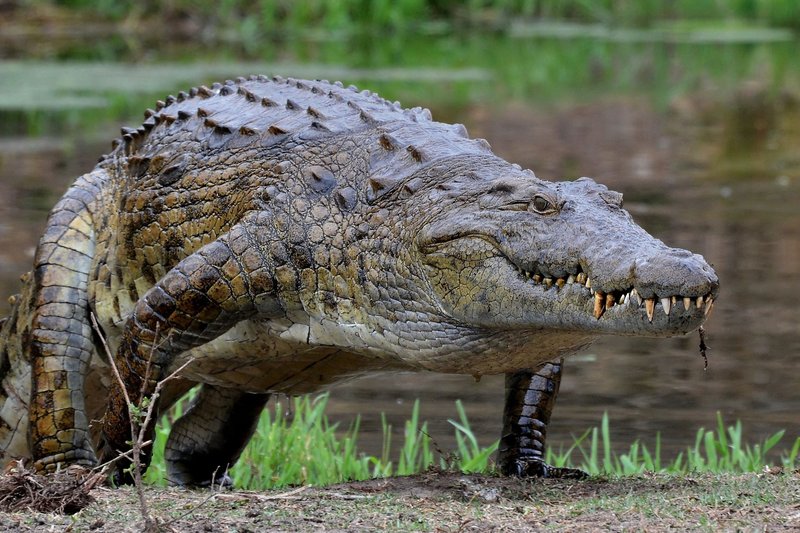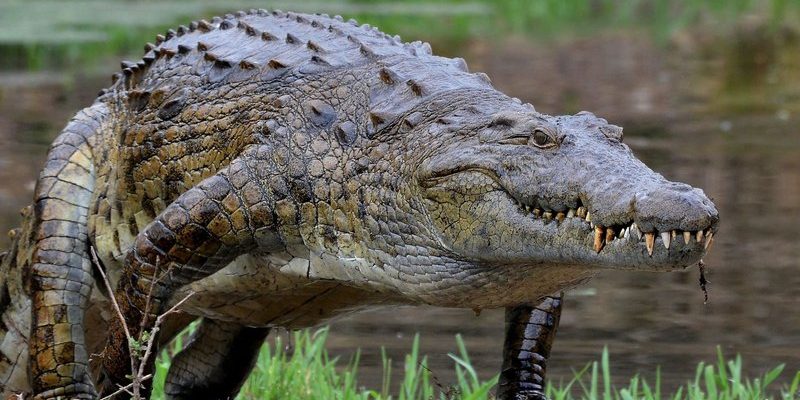
Let’s kick back and explore how these ancient creatures have adjusted to survive and even thrive in environments that can be pretty harsh. Imagine being a Nile crocodile: you’re not just a predator; you’re also a master of your surroundings. Through unique physical traits and behaviors, these reptiles have perfected the art of survival, leading to their success story in the animal kingdom.
Powerful Bite and Feeding Adaptations
The Nile crocodile’s bite force is something to marvel at. This reptile has one of the strongest bites in the animal kingdom, capable of delivering over 5,000 pounds of pressure. You might be wondering why this matters. Well, a powerful bite allows the crocodile to crush the bones of its prey, which often includes fish, birds, and even larger mammals.
When it comes to feeding, these crocs have an interesting tactic. They often use a method called “death roll,” where they can grab onto their prey and spin in the water. This powerful twisting motion helps them tear off chunks of meat. It might sound brutal, but it’s effective! What’s fascinating is how they can go long periods without eating—sometimes even up to a year—by slowing down their metabolism. This means they can survive in times when food is scarce, a need-to-know survival skill.
Camouflage and Stealth
Have you ever noticed how well a crocodile blends into its surroundings? This ability is more than just a party trick; it’s crucial for survival. The Nile crocodile’s skin is covered in a pattern of dark and light hues that mimic the rocky riverbeds and muddy banks where they reside. This natural camouflage allows them to lie in wait, perfectly hidden from both prey and predators.
Their stealth doesn’t stop at appearance. Nile crocodiles are also masters of stillness. They can remain almost completely motionless for hours, waiting for the right moment to strike. This level of patience is essential for an ambush predator. Imagine sitting quietly for hours, fully focused, and only then making your move—that’s the life of a Nile crocodile!
Adaptive Thermoregulation
Let me explain something vital: crocodiles are ectothermic, meaning their body temperature depends on their environment. This might sound like a disadvantage, but it actually gives them a unique edge. Nile crocodiles have developed behaviors to regulate their body heat. They bask in the sun to warm up or move into the shade or water to cool down.
This adaptation not only helps them maintain energy levels but also plays a role in their hunting strategies. A well-regulated body temperature gives them the stamina to chase prey when necessary while conserving energy during the heat of the day. Plus, it’s pretty interesting how they can control their heat so efficiently!
Parental Care and Nesting Behavior
Contrary to popular belief, Nile crocodiles are quite devoted parents. After the female lays her eggs, she takes on the vital role of protector. She builds a nest on riverbanks and guards it fiercely against potential threats, such as monitor lizards and birds. This nurturing behavior is crucial for the survival of the young crocs.
Once the eggs hatch, the mother helps the little ones reach the water, often carrying them gently in her mouth. This level of maternal care is rare among reptiles and shows an interesting adaptation in terms of ensuring the next generation has a fighting chance. It’s like a nature reality show, where survival is the ultimate goal!
Aquatic Adaptations
Think about how amazing it is that the Nile crocodile is equally at home in water and on land! Their webbed feet make them agile swimmers. Their strong, muscular tails serve as powerful paddles, propelling them through rivers with amazing speed. When you see a crocodile glide through the water, it looks effortless, but there’s a lot of power behind every stroke.
Additionally, their eyes and nostrils are positioned on the top of their heads, allowing them to see and breathe while almost entirely submerged. This adaptation makes hunting in water even easier, as they can stealthily approach prey without being noticed. Honestly, it’s like they’ve been fine-tuning their skills for millions of years—it’s no wonder they’ve survived!
Behavioral Adaptations: Social Structures and Communication
You might be surprised to learn that Nile crocodiles have complex social structures. They communicate through a series of vocalizations, body language, and even the way they position themselves within a group. This social aspect helps them establish dominance and cooperation during the mating season.
For example, during courtship, they perform head bobbing and other displays to attract mates. These behaviors not only help in reproduction but strengthen social bonds within groups. In a way, they have adapted to live with each other while still asserting their individuality, which is quite fascinating for reptiles!
The Nile crocodile is a remarkable example of how adaptations play an essential role in survival. From powerful bites to complex social behaviors, each trait helps this species thrive in an ever-changing environment. As we’ve explored, they’ve developed not just physical adaptations but also behaviors that ensure their lineage continues.
So the next time you think about the Nile crocodile, remember it’s more than just a fearsome predator; it’s a master of survival. These adaptations remind us just how innovative nature can be when it comes to the game of survival. Whether they’re lurking in the shadows or basking in the sun, Nile crocodiles are the ultimate survivors of their habitat, making their story one worth diving into.

